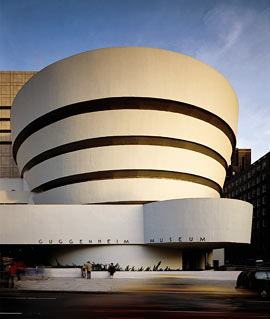 |
 |
 |
 |
 |
|
| Photo by David Heald. |
| The Solomon R. Guggenheim Foundation, New York | ||
The Solomon R. Guggenheim Foundation was incorporated in 1937, and the Museum of Non-Objective Painting, as it was then known, was established two years later. The museum—which assumed temporary residence in a former automobile showroom on East 54th Street in New York—took as its basis the radical new forms of art being developed by such artists as Vasily Kandinsky, Paul Klee, and Piet Mondrian. The insistence of philanthropist Solomon Guggenheim and artist-adviser Hilla Rebay on a wholly new kind of art seen in a wholly new kind of space set the institution on its unique path. The first permanent home for the museum was designed by Frank Lloyd Wright. He envisioned a building that not only broke the rectilinear grid of Manhattan but also shattered existing notions of what a museum could be. He conceived of its curving, continuous space as a "temple of spirit" where viewers could foster a new way of looking. Named the Solomon R. Guggenheim Museum in honor of its founder, the building opened in 1959, drawing huge crowds and stirring considerable controversy. It has never lost its power to excite and provoke, standing today as one of the great works of architecture produced in the twentieth century. Peggy Guggenheim, a niece of Solomon, donated her Venetian home, the Palazzo Venier dei Leoni on the Grand Canal, and the art collection housed in it to the Solomon R. Guggenheim Foundation in the mid-1970s. After her death, in 1979, the foundation took over full responsibility for the palazzo and the artworks, and the Peggy Guggenheim Collection—with its masterpieces ranging in style from Cubism and Surrealism to Abstract Expressionism—has become one of the most respected and visited cultural attractions in Venice. The Venice and New York museums together formed the basis for the institution's international orientation. Under the leadership of Thomas Krens, its director since 1988, the Guggenheim has increased the scope of its operations. In 1992, the Frank Lloyd Wright building was restored and supplemented by a new tower, adding considerable overall exhibition space while allowing Wright's great rotunda and the monitor building to be seen in all their splendor. At the same time, the Guggenheim Museum SoHo was opened in downtown Manhattan. In 1997, the institution expanded its international presence with the opening of the Guggenheim Museum Bilbao and Deutsche Guggenheim Berlin. Built by the Basque government and managed by the Guggenheim, the Guggenheim Museum Bilbao is part of a far-reaching plan to transform Bilbao into a major metropolitan center. The building, designed by Frank Gehry, has been hailed by critics worldwide as an architectural masterpiece. The result of a partnership between the Guggenheim and Deutsche Bank, the Deutsche Guggenheim Berlin is an intimate exhibition space on the historic Unter den Linden. In 2001, two sites designed by Rem Koolhas were opened in Las Vegas: the Guggenheim Las Vegas, a large exhibition space for the presentation of special exhibitions, ranging from contemporary art to architecture and design; and the Guggenheim Hermitage Museum, conceived as a "jewel box" for the presentation of exhibitions based on the collections of the Guggenheim and Hermitage museums. Looking to the future, the Guggenheim Virtual Museum will offer an enhanced presense on the Web. A window onto the different Guggenheim Musuems around the world, this project will provide a unique and compelling spatial environment to be experienced by the virtual visitor. Also on the horizon, the foundation has proposed the Guggenheim Museum New York, a new facility to be located in Lower Manhattan. Designed by Frank Gehry, it would feature galleries for special exhibitions and for works from the permanent collection as well as centers for arts and technology, architecture and design, and education. In the Fall 2001, the Sackler Center for Arts Education opened to the public. A 8,200 square-feet education facility, the Sackler Center comprises Studio-Art, Computer, and Multimedia Labs, the New Media Theater, an exhibition gallery, the Resource Center, the Conference Room, and education offices. It also includes the existing Peter B. Lewis Theater, part of Frank Lloyd Wright's original architectural design for the building. |